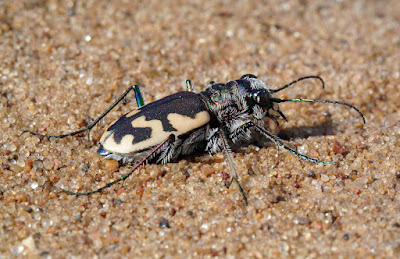"I cannot persuade myself that a beneficent and omnipotent God would have designedly created the Ichneumonidæ [parasitic wasps] with the express intention of their feeding within the living bodies of Caterpillars."
― Charles Darwin
Ever since I can remember I've thought of Nature hikes as if I'm a National Geographic explorer finding certain flora and fauna for the very first time. Even today, when I encounter the common, I mentally put them into a context that combines the uniqueness of the individual, its evolutionary history, and how fortunate I am to be able to experience such amazing scenes of natural beauty. I think about each creature's cognitive interiority and ponder what their window to the Universe might be like from their truly wild perspective.
We can assume birds have more greater sentience than insects, but is this correct? While there are interesting commonalities between insect brain structures and those of mammals and birds, when you observe an insect lose a limb in combat without any apparent signs of physical stress or emotional suffering, there must be differences in brain function and expressions of it. Even the midbrain of humans and insects share some degree of evolutionary relatedness. In fact, it's thought that insects may feel something that resembles hunger, pain, and possibly even simple analogs of anger and aggression, but they assuredly lack emotions like grief or jealousy.
When I've got my macro lens this close to a tiger beetle, I'm mere inches away in their little sandy insect realm. When I can get this close I can sometimes see their mouthparts moving, observe slight shifts in the position of their heads as they scan for prey. Sometimes they slightly open their elytra, then I know they're preparing to make an escape flight. The trick in sneaking up on them is to get as low as possible while making slow and fluid yoga-like movements toward them. Any mistake on my behalf prompts the beetle to make a 10 to 20 yard flight. I simply move onto the next beetle whenever that happens.
If you look carefully at the front maculation (outer shell pattern [forewing]) shape, you'll notice that most of these Big Sand Tiger Beetles are different individuals ― some are thicker, longer, shorter, flattened, or have a more C-shaped leading maculation. These patterns not only serve the insect by giving it a certain degree of camouflage, they also aid in thermoregulation by reflecting or absorbing light. That there is variability is good for natural selection and population dynamics should there be fluctuations in their immediate environment.
One can go deep into the science and ecology of it all, or simply admire these amazing little creatures. A mixture of scientist and yūgen is always present when I'm out in the field. Yūgen? It's a Japanese word that refers to an awareness that the Universe is so profound that the emotions we feel when we try to contemplate it are too deep and mysterious to convey. Why should humans experience such numinous sentiments with wild kin and the outdoors? There's little doubt that for early humans a reverence for Nature led to origins of animistic religious belief. In Nature, there's much that can be loved or feared. To approach it objectively and without anthropomorphisms can be a challenging endeavor.
Elsewhere in the woodland realm there were orchids and other wildflowers. The price for this slightly off-trail excursion came in the form of 5 Wood ticks and 2 Deer ticks. Nasty! Only one time did I miss a tick bite that necessitated antibiotics, but I have friends that have gotten some serious infections from them. Several years ago Sylvia got anaplasmosis that really wiped her out and has slight lingering symptoms to this day. She's had Lyme Disease, too.
One tries to be as careful as possible when out in Nature ― there are big things and small things that can take you out or make you sick. I've encountered bear and wolves in the wild, but rare is the case that they stick around and generally take off running upon seeing me. Rattlesnakes, Black Widow Spiders, and Poison Ivy sometimes give me a moment of jitters, but composure is never lost. But the most danger I've ever been in has almost always come in the form of that one particular weedy species, as Elizabeth Kolbert phrased us in her Pulitzer Prize-winning book The Sixth Extinction. We are and will continue to be our own worst enemy.
But ticks ... I hate'm! We can all get behind that, can't we?
All images © 2022 Mike McDowell


















